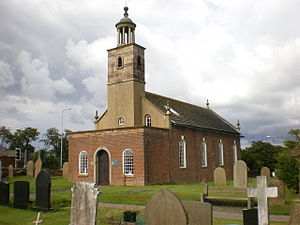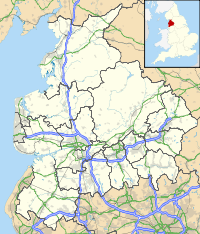- St Mary's Church, Tarleton
-
St Mary's Church, Tarleton 
St Mary's Church, Tarleton, from the southwestLocation in Lancashire Coordinates: 53°40′29″N 2°49′26″W / 53.6748°N 2.8239°W OS grid reference SD 456 201 Location Tarleton, Lancashire Country England Denomination Anglican Website Churches Conservation Trust Architecture Functional status Redundant Heritage designation Grade II* Designated 11 October 1968 Architectural type Church Style Georgian Specifications Length 47 feet 9 inches (14.55 m) Width 21 feet (6.40 m) Other dimensions Apse 12 feet (3.66 m) by
8 feet (2.44 m)Materials Brick with stone slate roofs;
ashlar in upper part of towerSt Mary's Church, Tarleton, is a redundant Anglican church which stands on the A59 road as it runs to the south of the village of Tarleton, Lancashire, England (grid reference SD456201). It has been designated by English Heritage as a Grade II* listed building,[1] and is under the care of the Churches Conservation Trust.[2]
Contents
History
Construction started on the church in 1718, funded by a donation from Henrietta Maria Legh, the sole benefactoress of the church, who resided at of Bank Hall.[3] By 1719 the church was completed on the site it stands today, where a former chapel of ease dating from before the Reformation once stood. Additions were made in 1824, consisting of a west porch, a south gallery, and an upper stage to the tower.[4] The church closed in 1886 when a new church dedicated to the Holy Trinity was built nearer to the centre of the village. It was then used as a mortuary chapel.[3] St Mary's was declared redundant on 1 November 1980, and was vested in the Trust on 10 February 1982.[5]
Architecture
Exterior
St Mary's is constructed in handmade brick that was originally plastered, with stone slate roofs and with ashlar upper parts to the tower. Its plan consists of a small rectangular building in four bays, with a semi-octagonal apse, a bell-tower at the west end, and to the west of this a flat-topped porch.[1] The church measures 47 feet 9 inches (14.55 m) by 21 feet (6.40 m), with the apse measuring 12 feet (3.66 m) by 8 feet (2.44 m).[3] Along the north and south walls are large round-headed windows containing glazing bars that are continued upwards into intersecting tracery. Above each window is a keystone, and between the windows are triangular pilasters which act as buttresses.
The apse has a similar window on each side, leaving the east end blank. Running down the east end is a rain drain pipe, its head being decorated with the arms of Banastre of Bank, and the date 1719. On the top of each corner and on the east gable end is a flaming-urn finial. Around the summit of the apse is a modillioned cornice. At the west end of the porch is a round-headed doorway with a keystone, on each side of which is a window similar to those on the sides. Rising above this, the west end of the church and the lower part of the tower are stuccoed. On each side of the tower is a small round-headed window, and an even smaller round-headed window is in the lower part of the tower.[1] The tower is thin and oblong.[4] On each side of the tower, above a string course, is a louvred bell opening with a triangular head, and around the top of the tower is a moulded cornice.[1] On its summit is a rotunda consisting of a cupola carried on columns, surmounted by a weathervane.[4]
Interior
The porch incorporates a vestry and stairs leading up to the panelled gallery. This occupies the west and south sides and is carried by square fluted columns. In the eastern part (front) of the church are box pews, that were created for George Anthony Legh Keck, a resident of the nearby mansion house of Bank Hall, (his initials can be seen on the pews), while the west wall contains open benches that where used for the local villagers.[4] In the middle of the north side is a reading desk. The pulpit is octagonal and panelled.[1] The font dates from the 18th century and consists of a simple baluster. Also in the church is a 19th-century cast iron stove decorated with wreathes standing on claw feet.[4] The floor is flagged.[1]
Present day
The church yard is still a working graveyard for the village of Tarleton, it is maintained by church volunteers who also open up the church to visitors on Heritage Open Days in September,[6] following a church service on the fourth Sunday of August every year known as 'Old Church Sunday'. This is when the service from the parish church of Holy Trinity, in the village of Tarleton, is transferred to St Mary's for that one day a year. Old Church Sunday has happened since Holy Trinity was opened in 1888, at the same time the weekly services were also transferred to Holy Trinity.
See also
- List of churches preserved by the Churches Conservation Trust in Northern England
References
- ^ a b c d e f "Church of St Mary, Tarleton", Heritage Gateway website (Heritage Gateway (English Heritage, Institute of Historic Building Conservation and ALGAO:England)), 2006, http://www.heritagegateway.org.uk/Gateway/Results_Single.aspx?uid=357749&resourceID=5, retrieved 9 September 2010
- ^ St Mary's Church, Tarleton, Lancashire, Churches Conservation Trust, http://www.visitchurches.org.uk/Ourchurches/Completelistofchurches/St-Marys-Church-Tarleton-Lancashire/, retrieved 28 March 2011
- ^ a b c Farrer, William; Brownbill, J., eds. (1911), "Tarleton: Church", A History of the County of Lancaster, Victoria County History (University of London & History of Parliament Trust) 6, http://www.british-history.ac.uk/report.aspx?compid=53083#s4, retrieved 9 September 2010
- ^ a b c d e Hartwell, Clare; Pevsner, Nikolaus (2009) [1969], The Buildings of England. Lancashire: North, New Haven and London: Yale University Press, p. 663, ISBN 978 0 300 12667 9
- ^ (PDF) Diocese of Blackburn: All Schemes, Church Commissioners/Statistics, Church of England, 2010, p. 6, http://www.churchofengland.org/media/810334/blackburn%20-%20all%20schemes.pdf, retrieved 3 April 2011
- ^ St Mary’s Old Church, Tarleton, Tarleton and Hesketh Bank website, http://www.heskethbank.com/home/stmarys/index.html, retrieved 10 September 2010
Categories:- Grade II* listed buildings in Lancashire
- Grade II* listed churches
- 1719 architecture
- 18th-century church buildings
- 1824 architecture
- Georgian architecture
- Churches preserved by the Churches Conservation Trust
Wikimedia Foundation. 2010.


